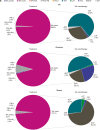Characteristics, Treatment Patterns, and Clinical Outcomes of Chronic Hepatitis B Across 3 Continents: Retrospective Database Study
- PMID: 36350533
- PMCID: PMC9898346
- DOI: 10.1007/s12325-022-02284-1
Characteristics, Treatment Patterns, and Clinical Outcomes of Chronic Hepatitis B Across 3 Continents: Retrospective Database Study
Abstract
Introduction: The prevalence of chronic hepatitis B virus (HBV) infection is high in many countries; however, robust, real-world epidemiological data are lacking. This study describes the prevalence, characteristics, treatment patterns, and long-term clinical outcomes of patients with chronic HBV infection in the US, Germany, and Taiwan.
Methods: This was a retrospective cohort analysis of three healthcare/insurance claims databases. Individuals were identified as patients with chronic HBV infection if their records contained HBV diagnostic codes from 1 January 2010 to 31 December 2012 (Germany and Taiwan) or 1 January 2013 (USA). Included patients were indexed on 1 January 2013. Patients' demographics, clinical characteristics, and healthcare utilisation were described. Treatment patterns and long-term clinical outcomes over follow-up (to 31 December 2016 or loss to follow-up) were estimated.
Results: The prevalence of chronic HBV infection was 0.10%, 0.17%, and 2.39% in the US, Germany, and Taiwan respectively. Prevalence was very low in children, increased rapidly in adulthood, and peaked in 50- < 65 year olds before declining in the elderly. More US (16.6%) and German (15.4%) patients were HIV ± HCV coinfected than in Taiwan (4.1%). Baseline clinical characteristics and healthcare utilisation were broadly similar between countries. In total, 19.2%, 11.1%, and 5.9% of non-coinfected adult patients received treatment at index in the US, Germany, and Taiwan, respectively; most frequently with nucleos(t)ide analogue monotherapy (94.4%, 97.2%, 99.8% of treated patients, respectively) and rarely with interferons (0.27%, 1.63%, and 0.06%, respectively). Untreated Taiwanese patients were more likely to remain untreated than elsewhere, and treated Taiwanese patients were less likely to persist with therapy. Generally, the cumulative incidence of long-term clinical outcomes was lowest in Germany.
Conclusion: This study provides a contemporary, real-world, intercontinental snapshot of chronic HBV infection. Long-term sequelae occurred in all populations, and treatment levels were low, suggesting an unmet need for (or access to) effective treatments.
Keywords: Epidemiology; Hepatitis B virus; Prevalence; Sequelae; Therapeutics.
© 2022. GSK.
Figures








References
-
- World Health Organization. Hepatitis B factsheet; https://www.who.int/news-room/fact-sheets/detail/hepatitis-b. Accessed Sep 15, 2020.
-
- World Health Organization. Global hepatitis report, 2017; https://www.who.int/hepatitis/publications/global-hepatitis-report2017/en/. Accessed Sep 15, 2020.
Publication types
MeSH terms
Substances
LinkOut - more resources
Full Text Sources

